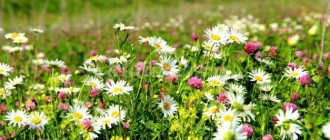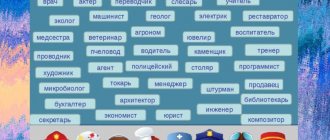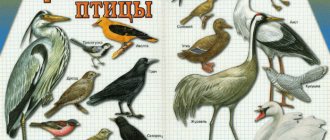Summary of OOD for the preparatory group “Winter-Winter” using an interactive presentation
LESSON SUMMARY ON FCCM IN THE PREPARATORY GROUP “NATURAL PHENOMENA OF WINTER” USING
INTERACTIVE PRESENTATION “ZIMUSHKA-WINTER”
GOAL: Expanding children's knowledge about the natural phenomena of winter.
TASKS:
Educational objectives:
- to reinforce with children natural phenomena in winter, seasonal changes in nature,
associated with the winter period
;
- consolidate knowledge about the winter months ;
—
continue to get acquainted with the properties of snow and its structure.
Developmental tasks:
-develop children’s ability to give detailed answers, develop children’s imagination.
-continue to develop basic experimentation skills.
Educational tasks:
- to cultivate interest in studying nature, love for it, the ability to see the beauty of the world around us.
MATERIALS AND EQUIPMENT: interactive whiteboard, laptop, 2 jars, funnel, filter paper, glass, magnifying glasses.
PROGRESS OF THE CLASS:
Educator:
Guys, listen to the riddle and guess what it is about. (2 slide).
I have a lot to do - I cover the whole earth with a white blanket, clear the rivers of ice, I whitewash fields, houses, and my name is... (winter).
Children's answers.
Educator:
Right! Today we will talk about winter and its phenomena. Let's remember the names of the winter months.
Children's answers.
Educator:
Right. (3-5 slide) December is the oldest, most recent and oldest month of the year. January is the very first, youngest month of the new year. February is the last winter month. It is the second month of the year.
Educator:
Guys, look at the picture. (slide 2). It depicts winter. Tell me, what time of year is there before winter?
Children's answers.
Educator:
What time of year will come after winter?
Children's answers.
Educator:
Right. What do you think is the first sign of winter?
Children's answers.
Educator:
One of the main signs of winter is snow. (slide 6). If we look at snow under a microscope, we will see that snow consists of small crystals - snowflakes. There are no identical snowflakes. Each snowflake is unique (slide 7). Tell me, what is snow?
Children's answers.
Educator:
Snow is frozen water. And now we will conduct experiments with snow. Look, there is snow in the jars. What happens to snow if we leave it in the room?
Children's answers.
Educator:
It will melt correctly. Guys, tell me, can I eat snow?
Children's answers.
Educator:
What you say is correct, you can’t eat snow, it’s dirty. And now we will be convinced of this. To do this, you and I will need melt water, which was formed from melted snow, a funnel, filter paper and a transparent glass. We will put filter paper in the funnel. And let's pour water. See what's happening?
Children's answers.
Educator:
The water flows down into the glass, and everything that was in the water remains on the paper. Let's see what's left on the paper through a magnifying glass.
Children examine the paper through a magnifying glass and comment on their observations.
Educator:
If you and I look at a drop of water under a microscope, we will see how many different microorganisms there are in it. (slide 8).
Educator:
Tell me what will happen to the water if it is taken outside again.
Children's answers.
Educator:
Correctly, it will freeze and turn into ice.
Now, remember what winter phenomena in nature we can observe?
Children's answers.
Educator:
I will help you. The answers to my riddles will be just phenomena in nature in winter.
Who sweeps and gets angry in winter,
Blowing, howling and spinning?
Makes a white bed
This is a snowy... (blizzard) (slide 9)
Educator:
A blizzard is the movement of snow over the ground by powerful and gusty winds. In this case, the snow usually moves in one direction. For humans, a blizzard causes a number of inconveniences: it makes breathing and movement difficult and noticeably impairs visibility.
Everything underfoot is slipping away and floating somewhere. Both funny and scary: On the road...(ice) (slide 10)
Educator:
Ice is a layer of dense ice formed on the surface of the earth, sidewalks, roadways and on objects (trees, wires, etc.) when rain and drizzle (fog) freeze. Ice usually occurs at air temperatures from 0°C to minus 3°C. The crust of frozen ice can reach several centimeters. When there is ice, move carefully, slowly, stepping on the entire sole. In this case, the legs should be slightly relaxed and the hands should be free. Elderly people are recommended to use a cane with a rubber tip or a special stick with pointed spikes.
The wind blew and frost brought us snow from the north. Only ever since then, on my glass...(patterns) (slide 11)
Educator:
How do patterns appear on glass? Frost cools the glass, water vapor curls from inside, settles into a thin film (the glass looks foggy), and the water gradually turns into crystals. The growth of frosty patterns is directed by the glass surface itself. There are always microscratches, bumps, and dust on it, and these become centers from which crystal growth begins along the glass. The patterns are also affected by its thickness, temperature difference, movement of warm air, and impurities in the water film. Frost begins to appear on the window from below, where there is more moisture and the air is colder. That’s why the branches of the patterns are thicker here. When there is little moisture, islands of stains and patterns remain on the glass.
Not prickly, light blue. Hung around the bushes...(frost) (slide 12)
Educator:
Frost is a thin layer of ice crystals. Where do they come from? From the air. There is always water vapor in it. The colder it is, the less moisture it can hold. When it gets cold, “excess” moisture leaves the air and settles in crystals on various objects: cars, fences, branches of trees and bushes. Frost appears more often at night when it gets colder. A weak wind helps with this - it cools and accelerates the transfer of heat. The shape of the crystals depends on temperature. When it drops below –15°C, they look like short needles; if it gets warmer, the frost becomes lamellar.
Educator:
Guys, today we remembered what natural phenomena happen in winter. Now tell me which natural phenomenon did you like best and why?
Children's answers.
Preparatory group. Senior preschool age. Children 6-7 years old
Summary of a lesson on appliqué with elements of drawing in the preparatory group “Bullfinch”
Goal: developing the ability to perform appliqué without templates according to a sample after explaining the sequence of work. Objectives: - expand children’s understanding of wintering birds; - develop the ability to convey your observations of living nature to...
Summary of a drawing lesson using semolina and PVA glue, preparatory group “Magic Winter Forest”
Summary of a drawing lesson using an unconventional semolina drawing technique on the topic: “Magic winter forest ”
winter impressions in their work , the beauty of a snow-covered landscape...






